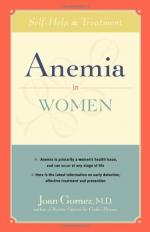|
This section contains 465 words (approx. 2 pages at 300 words per page) |

|
Anemia is a medical condition in which the red cells of the blood are reduced in number or volume or are deficient in hemoglobin, their oxygen-carrying pigment. Almost 100 different varieties of anemia are known. Iron deficiency is the most common cause of anemia worldwide. Other causes of anemia include ionizing radiation, lead poisoning, vitamin B12 deficiency, folic acid deficiency, certain infections, and pesticide exposure. Some 350 million people worldwide—mostly women of child-bearing age—suffer from anemia.
The most noticeable symptom is pallor of the skin, mucous membranes, and nail beds. Symptoms of tissue oxygen deficiency include pulsating noises in the ear, dizziness, fainting, and shortness of breath. The treatment varies greatly depending on the cause and diagnosis, but may include supplying missing nutrients, removing toxic factors from the environment, improving the underlying disorder, or restoring blood volume with transfusion.
Aplastic anemia is a disease in which the bone...
|
This section contains 465 words (approx. 2 pages at 300 words per page) |

|


